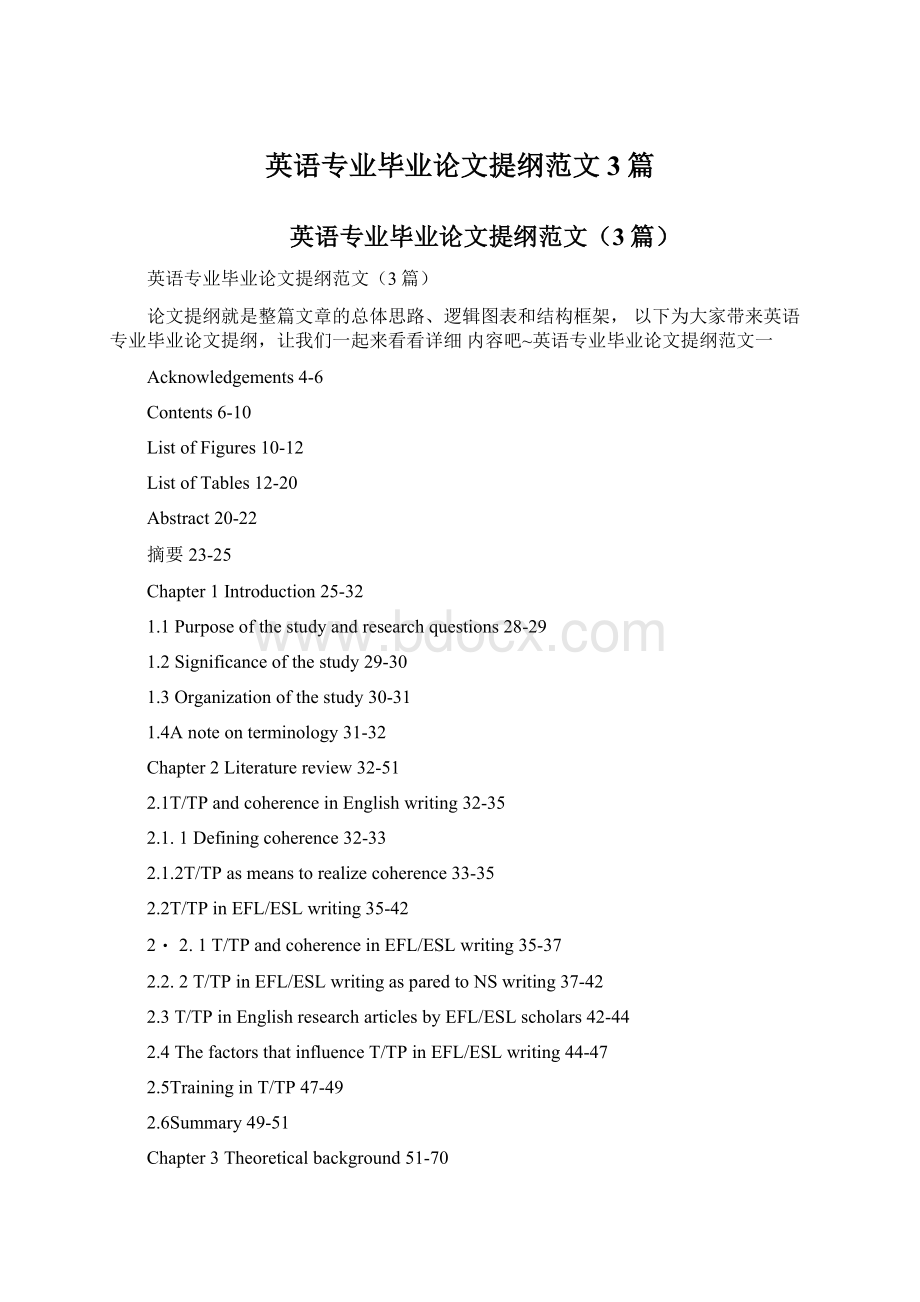英语专业毕业论文提纲范文3篇.docx
《英语专业毕业论文提纲范文3篇.docx》由会员分享,可在线阅读,更多相关《英语专业毕业论文提纲范文3篇.docx(9页珍藏版)》请在冰豆网上搜索。

英语专业毕业论文提纲范文3篇
英语专业毕业论文提纲范文(3篇)
英语专业毕业论文提纲范文(3篇)
论文提纲就是整篇文章的总体思路、逻辑图表和结构框架,以下为大家带来英语专业毕业论文提纲,让我们一起来看看详细内容吧~英语专业毕业论文提纲范文一
Acknowledgements4-6
Contents6-10
ListofFigures10-12
ListofTables12-20
Abstract20-22
摘要23-25
Chapter1Introduction25-32
1.1Purposeofthestudyandresearchquestions28-29
1.2Significanceofthestudy29-30
1.3Organizationofthestudy30-31
1.4Anoteonterminology31-32
Chapter2Literaturereview32-51
2.1T/TPandcoherenceinEnglishwriting32-35
2.1.1Definingcoherence32-33
2.1.2T/TPasmeanstorealizecoherence33-35
2.2T/TPinEFL/ESLwriting35-42
2・2.1T/TPandcoherenceinEFL/ESLwriting35-37
2.2.2T/TPinEFL/ESLwritingasparedtoNSwriting37-42
2.3T/TPinEnglishresearcharticlesbyEFL/ESLscholars42-44
2.4ThefactorsthatinfluenceT/TPinEFL/ESLwriting44-47
2.5TraininginT/TP47-49
2.6Summary49-51
Chapter3Theoreticalbackground51-70
3・1SystemicFunctionalGrammar51-55
3.1.1Fivedimensionsoflanguageasasemiotic
system51-53
3.1.2Threemetafunctionsoflemguageasafunctionalsystem53-54
3.1.3Threelinesofmeaningfrommetafunctions54-55
3.2Themeandthematicprogression55-70
3.2.1Theme56-62
3.2.2Thematicprogression62-70
Chapter4ResearchDesign70-88
4.1Theparticipantsandtheeducationalcontext70-
4.1.1Backgroundoftheparticipantsandthe
participatingschool70
4.1.2
Theallocationofparticipantstothetraining
70—71
4.1.3
Theslesizes71-72
4.1.4
Thepilotstudy72-73
4・2Theinterventionalprocedures73-74
4.3Thequestionnaire74-75
4.4Thetraining75-80
4.4.1
Considerationsbehindthetraining75-76
4.4.2
Thetrainingmaterial76-79
4.4.3
Theroleoftheresearcherasthetrainer79—80
4・5Deitdanalysis80-86
4.5.1Analysisofthewriting80-86
4.5.2Analysisofthequestionnaire86
4・6Ethicalconsiderations86-88
4.6.1Informedconsent86-87
4.6.2Anonymity87
4.6.3Harm87-88
Chapter5ResuItsandanalysisofpre-training
writing88-115
5.1parisonofThemesinEELpre-trainingwritingandCELpre-writing88-102
5・1.1Topical‘textualandinterpersonalThemes88-91
5.1.2TopicalThemes:
markedandunmarkedThemes91-95
5・1.3TextualThemes:
continuatives,conjunctionsandconjunctiveadjunets95-100
5・1.4InterpersonalThemes100-102
5.2parisonofthematicprogressioninEELpretrainingwritingandCELpre-writing102-110
5.2.1Linear,constant,suinniEitiveandsplitprogressions102-107
5.2.2Back,contextualandnewThemes107-110
5.3Summary110-115
Chapter6ResuItsandanalysisofpost-trainingwriting115-137
6.1parisonofThemesinEELpost-trainingwritingandCELpost-writing115-129
6.1.1Topical‘textualandinterpersonalThemes115-
117
6.1.2TopicalThemes:
markedandunmarkedThemes117-
121
6.1.3TextualThemes:
continuatives,conjunctionsandconjunctiveadjuncts121-126
6.1.4InterpersonalThemes126-129
6.2parisonofthematicprogressioninEELpost-
trainingwritingandCELpost-writing129-132
6.2.1
Linear,constant,summativeandsplit
139
7.1.2TopicalThemes:
markedandunmarkedThemes139-
142
7.1.3TextualThemes:
continuatives,conjunctionsandconjunctiveadjuncts142-145
7.1.4InterpersonalThemes145-147
7.2parisonofthematicprogressioninpre-andpost-trainingwriting147T50
7.2.1Linear,constant,suinmativeandsplitprogressions147-149
7.2.2Back,contextualandnewThemes149-150
7.3Summary150-155
Chapter8ResuItsandanalysisofthequestionnaire155-165
8・1Findingsfromclosedquestions155T60
8.1.1EELparticipantsgeneralattitudetotrainingonT/TP155-157
8.1.2EELparticipantsperceptionoftheusefulnessofthetrainingonT/TP157-158
8・1.3EELparticipantsperceptionofthelearnabilityofT/TP158-159
8.1.4EELparticipantsperceptionoftheapplicabilityofT/TPinwriting159-160
8.2Findingsfromopenquestions160-164
8.2.1Thechangesthatoccurred161-162
8.2.2TheperceiveddifficultyofapplyingthetheoryofT/TPinwriting162-163
8.2.3Thereasonsfortheperceiveddifficultyinlearning163
8.2.4EELparticipantssuggestionsforfuture
training163-164
8.3Summary164-165
Chapter9Discussion165T95
9.1Findingswithregardtoresearchquestions165-
187
9.1.1ChinesecollegestudentsuseofT/TPinpretrainingwriting165-172
9.1.2ChinesecollegestudentsuseofT/TPinpost-
trainingwriting172-181
9.1.3EffectsofthetrainingonT/TPinChinesecollegestudentsEnglishwriting181-187
9.2Positioningthestudywithintheliterature187-190
9.2.1T/TPinChinesecollegestudentsEnglishwriting187-189
9.2.2EffectsoftrainingonChinesecollegestudentsuseofT/TP189-190
9.3Implications190-194
9.3.1Pedagogicalimplication190-193
9.3.2Methodologicalimplication193-194
9.4Limitations194-195
Chapter10Conclusion195-200
10.1Summary195-197
10.2Puttingeverythingtogether197-199
10.3Suggestionsforfuturework199-200
Notes200-202
References202-214
Appendix1:
Planfortheinterventionalprocedures214-215
Appendix2:
Thepost-trainingquestionnaire215-217
Appendix3:
Trainingmaterial217-229
Appendix4:
Teachersguidetothetraining229-237
Appendix5:
ConsentformforEELgroup237-238
Appendix6:
ConsentformforCELgroup238-239
Appendix7:
ConsentformforNSgroup239英语专业毕业论文提纲范文二
中文摘要3-4
ABSTRACT4
ChapterOneIntroduction7T0
1.1Motivationofthepresentstudy7-8
1.2Significanceofthisstudy8
1.3positionofthisthesis8T0
ChapterTwoLiteratureReview10T9
2.1Languageproduction10-14
2.1.1LIProduction10-11
2.1.2L2Production11-12
2.1.3Dimensionsoflanguageproduction12T4
2.2Theoriesonoraloutput14-15
2.2.1Skehansdual-modelsystem14
2.2.2SwainsOutputHypothesis14-15
2.3TaskRepetition15-17
2.3.1Task15-16
2.3.2Taskrepetition16-17
2.4Relevantstudiesoneffectsoftaskrepetitionon
L2oraloutput17T9
CHARPTERTHREETHECURRENTSTUDY19-25
3.1Researchjustificationandquestions19
3.2Hypothesis19-20
3.3Methods20-25
3.3.1Participants20-21
3.3.2Material21
3.3.3Researchdesign21-23
3.3.4Measures23-25
ChapterFourResultsandDiscussion25-41
4.1ResultsandAnalysis25-34
4.1.1Quantitativeanalysis25-27
4.1.2Qualitativeanalysis27-34
4.2Discussion34-41
4.2.1Fluency34-36
4.2.2plexity36-38
4.2.3Accuracy38-39
4・2.4interlanguagedevelopmentpathoflearnerL39-
41
ChapterFiveConclusions41-44
5.1Conclusionandimplication41-43
5.2Limitationsandremendations43-44
Acknowledgements44-45
References45-49
Appendixes49-54
A.Instruetionsoftheexperiment49-50
B.Thesame-contenttask50-51
C.Thedifferent-contenttask51-52
D.Sleoforalpre-task52-53
E・Sleoforalpost-task53-54
F.Sleofwritingrepetitiontask54英语专业毕业论文提纲范文三
一、英语谚语的概述
1.1.对谚语的一般定义,并概括英语谚语的基本特点(35条)
1.2.结合谚语与语言的关系,简要论述英语谚语来源的一般性概述
这一部分大体写2000字。
二、西方的宗教传统与英语谚语的本源关联
2.1对基督教的历史做一简单的概述,同时对《圣经》对基督教的核心意义与价值做一简单的说明
2.1.1.简述西方的宗教传统,或者基督教的历史
2.1.2.对基督教的基本信义做一简单的概述,从下述几个方面:
(1)对基督教的只信仰一个唯一的上帝,不容许进行偶像崇拜;
(2)原罪的观念与救赎的观念:
涉及末世审判、救赎恩典和得救的观念
(3)爱是基督教信仰的核心,核心是爱上帝,同时爱每个人
归根结底,基督教是一种高级的精神性宗教,深深地浸透入了西方世界的每一个角落
2.2英语谚语与基督教的关系,特别是《圣经》的英译对英语的影响
(1)《圣经》历史上的英译本,主要讲钦定本的诞生和影响
(譬如扩大了英语的词汇量、增强了英语的、表意功能、增加了英语的表意手段等等)
(2)通过一些简单的例证来说明从拉丁语翻译到英语这一过程的影响与意义(如可以举例一些特殊的词语、句式等说明,做好这一部分关键是找到好的研究资料)
三、对源于《圣经》的谚语进行分析,揭示其宗教、文化内涵
(选取若干源于《圣经》的谚语进行具体的、细致的分析,以揭示谚语背后的宗教内涵和英语所负载的宗教文化意义。
)
1.选取1520条有代表性的谚语进行分析,
(1)简述一下选取分析对象的标准
首先这些谚语必须来源于《圣经》或者有《圣经》直接引伸出来,
其次这些谚语必须是应用较广,家喻户晓,且包含特定的智慧
(2)对这些谚语进行分析
我们的分析角度或方法是:
1、要将这些谚语放到《圣经》的文本中去,也就是要将其放回到具体的语境中,在具体的故事或圣经人物的言说中领会这些谚语的内涵
2、可以适当的结合这些谚语的修辞、句式结构等来分析
2.对上述谚语分析之后,从若干角度进行文化内涵的总结和概括
这些谚语的内在价值:
道德规范、人生智慧、
这些谚语的功能:
宗教教化功能、规导劝慰功能、
(这些价值功能关键的根据所选谚语的分析来确定,有新的发现可适当再添加)
这一部分为本文的主体部分,在3500字左右
附:
拟订提纲的步骤与方法
第一步,明确文章的大小题目。
在研究文献和确立三论阶
段,已经确立了文章的总论点,以及若于不同层次的分论点。
从文章的形式上看,这些分论点便是不同层次的大小标题。
一般来说,一篇文章至少应设立3个层次的大小标题。
文章的总题目加上这些大小标题,便是文章的基本框架,也是写作提纲的主要内容。
丨
第二步,为大小标题排序。
根据总论点的论证需要,以及大小标题之间存在的相互逻辑关系,将这些标题排序,并标注序码。
第三步,材料对号入座。
将选定的、将要写进文章中的材料也根据论证的需要分组,并编注序号。
然后,分别以序号的形式对号入座,安插在各个大小标题之下。
这样,写作提纲便基本完成。
提纲完成之后,还必须进行仔细推敲、反复调整、及时修改。
毋庸置疑,调整与修改提纲比全文写完之后再推倒重来,进行大返工要节省很多时间和精力。
提纲的修改可以在动笔撰写初稿之前,集中时间和精力进行,以便确立文章的基本框架结构。
在撰写初稿的过程中,有时也有必要回过头来再对提纲进行局部的、细节的调整与修订。